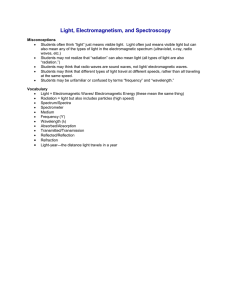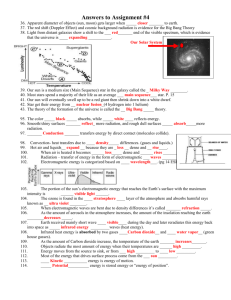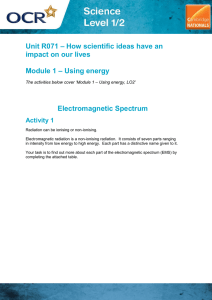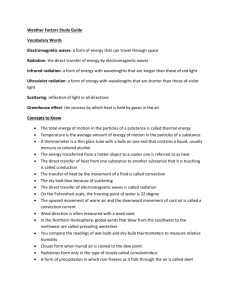Remote Control: How it Works
advertisement
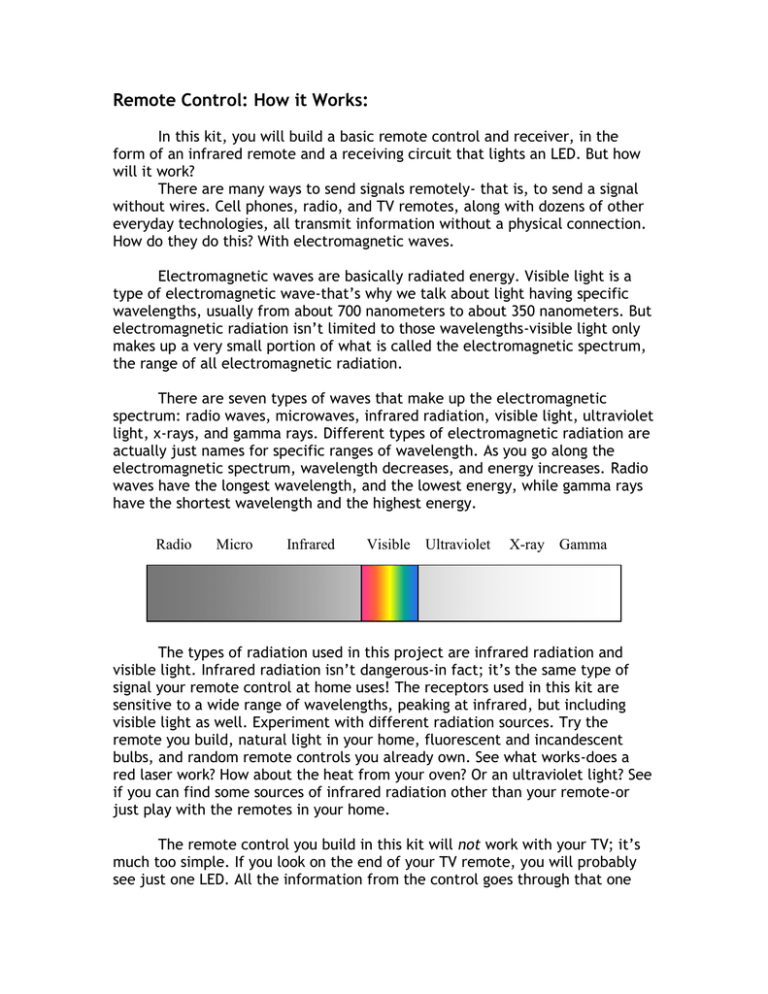
Remote Control: How it Works: In this kit, you will build a basic remote control and receiver, in the form of an infrared remote and a receiving circuit that lights an LED. But how will it work? There are many ways to send signals remotely- that is, to send a signal without wires. Cell phones, radio, and TV remotes, along with dozens of other everyday technologies, all transmit information without a physical connection. How do they do this? With electromagnetic waves. Electromagnetic waves are basically radiated energy. Visible light is a type of electromagnetic wave-that’s why we talk about light having specific wavelengths, usually from about 700 nanometers to about 350 nanometers. But electromagnetic radiation isn’t limited to those wavelengths-visible light only makes up a very small portion of what is called the electromagnetic spectrum, the range of all electromagnetic radiation. There are seven types of waves that make up the electromagnetic spectrum: radio waves, microwaves, infrared radiation, visible light, ultraviolet light, x-rays, and gamma rays. Different types of electromagnetic radiation are actually just names for specific ranges of wavelength. As you go along the electromagnetic spectrum, wavelength decreases, and energy increases. Radio waves have the longest wavelength, and the lowest energy, while gamma rays have the shortest wavelength and the highest energy. Radio Micro Infrared Visible Ultraviolet X-ray Gamma The types of radiation used in this project are infrared radiation and visible light. Infrared radiation isn’t dangerous-in fact; it’s the same type of signal your remote control at home uses! The receptors used in this kit are sensitive to a wide range of wavelengths, peaking at infrared, but including visible light as well. Experiment with different radiation sources. Try the remote you build, natural light in your home, fluorescent and incandescent bulbs, and random remote controls you already own. See what works-does a red laser work? How about the heat from your oven? Or an ultraviolet light? See if you can find some sources of infrared radiation other than your remote-or just play with the remotes in your home. The remote control you build in this kit will not work with your TV; it’s much too simple. If you look on the end of your TV remote, you will probably see just one LED. All the information from the control goes through that one LED. But with just one emitter, how does the TV’s receiver tell when you press the play button, and when you want to pause? What happens when you press the pause button-or any other button, for that matter-is that the remote blinks the LED on and off very quickly, in a unique frequency. The TV receiver recognizes each frequency, and uses that to distinguish between commands. Your home-made remote doesn’t have that function, which is why it won’t work on your TV. But your TV remote WILL work on your receiver. Try it out. If you look carefully, you may be able to see the LED blinking on and off very quickly. That’s the same frequency the TV remote is emitting, just shown in visible light. So here’s what we know so far: remote control uses electromagnetic radiation to send out information, and more complex information can be encoded by varying the frequency of the radiation pulses. Next topic: how the information is received. You probably know the basic explanation of a solar cell: light shines on it, and electricity is generated. For more information on how solar cells work, read Appendix A. The receivers used in this kit are a lot like solar cells, just on a smaller scale: illuminate them, and get a small voltage output. These “mini solar cells” are called phototransistors. A transistor is an electronic component that allows voltage to flow whenever it receives a signal in the form of electricity. A phototransistor uses light to generate that signal, and then allows some current to flow. Because phototransistors typically give off very little electricity, this kit uses two in conjunction with a regular transistor. When the light shines on the phototransistors, they emit a signal, which in turn triggers the regular transistor. The regular transistor is powerful enough to generate the voltage needed to light the LED. Once you’ve built your receiver circuit, try covering just one of the phototransistors. What do you expect to happen? What does happen? Also try varying the intensity of the signal to your circuit. For a circuit diagram, check out Appendix B. That’s it for the basics of remote controls-have fun! Appendix A How Solar Cells Work A solar cell is generally a large, flat wafer of silicon. This is what the silicon atoms look like when they form a layer: (The dotted lines represent bonds between atoms) Si Si Si Si Si Si Si Si Si There are other elements interspersed into the silicon crystal structure, to create irregularities for electrons to flow into once they get moving. Light is made up of photons, which are tiny particles with no mass. * When light hits a solar cell, it knocks electrons loose. The electrons move until they can find a new spot to rest in one of the irregularities in the silicon wafer. If the light keeps shining, more electrons pop off and move around. When each electron gets knocked loose, it leaves behind a hole that another electron can fill. Because electrons are moving around, there is a flow of charge-in other words, an electric current. That’s how solar cells generate electricity! * I referred to light as a wave earlier, and now I’m calling it a particle. Which is it? The answer is both. Light can act as either a particle or a wave. This property is called wave-particle duality. For more on wave-particle duality, I recommend this video: http://www.youtube.com/watch?v=DfPeprQ7oGc Appendix B

